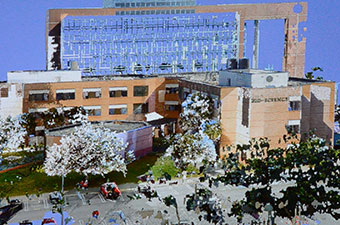Spotlight
Virtual Campus
| USF News

Using 3-D laser scanning, students are creating a virtual campus.
Illustration courtesy of Lori Collins
Using 3-D laser scanners, global positioning systems, geographical information systems and high-tech computer software, scientists at USF are working with graduate and local high school students to create a virtual campus.
“The idea is to give them sort of a living classroom,” says Lori Collins, who along with Travis Doering, directs the university’s Alliance for Integrated Spatial Technologies (AIST). “This is going to make USF one of the smartest campuses.”
For years, Collins and Doering have traveled the world documenting and preserving 3-D replications of historic monuments and imperiled World Heritage Sites. Now, they’re bringing the cutting-edge techniques they’ve perfected to a familiar location — the USF Tampa campus.
USF alums Collins and Doering began work on the project this summer with the help of AIST team members and high school students enrolled in a summer STEM course.
The virtual campus model starts with 3-D laser scans of campus buildings, accurate to the millimeter. The scans are combined with geographical information and global positioning to create the living document that can be used for virtual tours, security, sustainability, efficiency and other purposes.
Collins says the project will be continually updated and stocked full of current and historical information about the locations. The virtual tour, she adds, will have an augmented reality feature, allowing users to access the site with a mobile device and learn more about that particular location.
“So you can take the 3-D model of the library, you can come into our campus and look at the library and through your own device — through a phone or a tablet — once we tag that spot with information, you can then view things about that building. So the building can talk to us, the building can tell us its story,” says Collins.